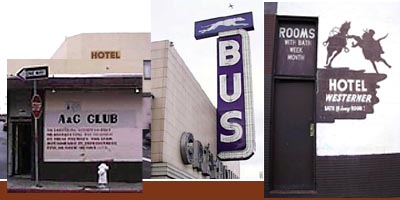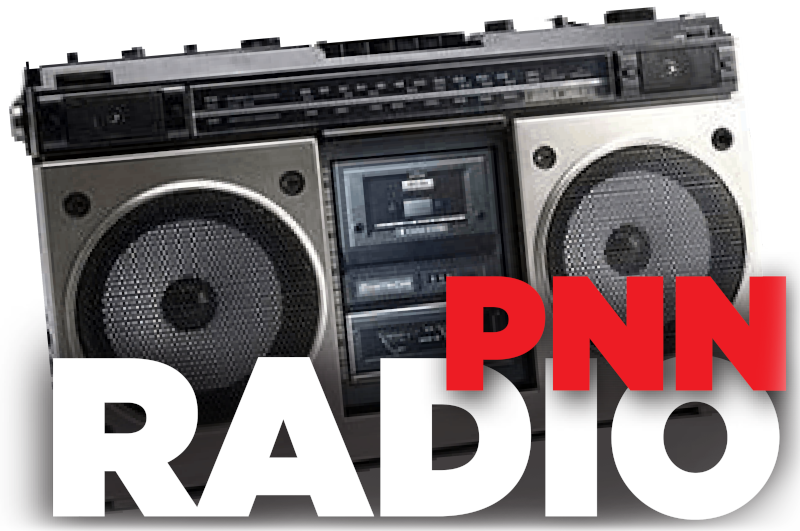PNN staff march in solidarity with the Just Cause Oakland eviction tour..and the at-risk tenants speak out from the front-line
 |
|
by Tiny and Ronnie Stevens He was standing there, his swollen fingers holding onto the wrought iron grate in front of the building. As he opened his chapped lips into smile - one proud tooth glistened out of a dark mouth "Join us" I yelled into him while clutching my banner. "Stop the Unfair Evictions" The group of several hundred marchers yelled in unison behind me. I was part of a march against evictions organized by Just Cause Oakland. We had stopped in front of 1918 San Pablo, The Westener Hotel - one of several locations slated for "renovation" (read gentrification) i.e., the destruction of a community in the name of improvement. The building was the color of soiled egg cream with dark brown trim. The Westerner - Daily..Weekly..Monthly was hastily painted in chocolate letters on the side... "What’s your name?," I called in to the man at the gate. "Ronnie" He answered slowly "You know, the city is planning to tear this building down" I whispered to him. He shook his head slowly from side to side- "I know", he mouthed the words silently.." I know..." "Come in to POOR Magazine- tell your own story - fight back...you are not powerless in all of this..." As the march continued on and I waved goodbye to Ronnie, I remembered Boona Cheena's (from B.O.S.S.) words to me at the rally that proceeded the march, " We have to organize immediately to prevent this (The Westener) eviction - rally's are great but that's not enough, we can't let these kinds of evictions happen at all- we can't let more poor folks be swept out of Oakland." Ronnie I don't have many friends, in fact, I don’t have any.. excepting John. He doesn't say much and he moves very slowly, I think he is getting older and each day it shows more and more- even his antennas move slower than usual. John is a cockroach, and my roommate at the Westerner Hotel - the same hotel that the city of Oakland plans to demolish which will make the quality of my already meager life even worse. Since I lost my job several years ago due to a disability, I have been addicted to heroin on and off for the last ten years. Somewhere in all of this I lost my nerve to keep trying. And yet, I wake up every day and buy food, cigarettes, paper towels and toilet tissue, and with a rigid regularity, pay my rent. In other words, in some way, I contribute to society. This place (The Westener) isn’t much to look at but it’s mine- a roof- that I can afford. A bed that is inside and a toilet, that I am allowed to use. I have been homeless, and I don’t want to be homeless again. If I am evicted, I really have nowhere else to go. Mayor Jerry Brown wants to revitalize Oakland’s downtown by building housing for 10,000 new residents. This "10k plan is designed to attract new retail and entertainment to create a bustling urban atmosphere. But who will be bustling? While the new housing is targeted to households with incomes of $75,000 to $100,000 and more, low income people are being evicted and displaced from their long-time homes. Nonprofit organizations and social service agencies serving the homeless and very low income are being told they are no longer welcome downtown. And the city refuses to enact a Just Cause Eviction ordinance that would protect tenants citywide from unfair evictions. The centerpiece of the 10k effort is a proposal from Forest City Enterprises, a major national developer from Cleveland, to build 2,000 new housing units in an area the city has termed "Uptown," the triangle between Telegraph and San Pablo Avenues, 17th and 20th Streets. Yes, there are vacant and underutilized parcels of land in this area, but there is also a The Just Cause Oakland coalition supports bringing new residents, new businesses and entertainment venues to downtown Oakland. But that process can and must be done in a way that maintains opportunities for low income residents, downtown workers, artists, nonprofit organizations, social service agencies, and neighborhood-serving businesses to preserve Oakland’s unique cultural and economic diversity. The following are a list of the stops on the eviction tour. The Just Cause Eviction Tour; First Step First Step provided shelter, meals, employment assistance, housing assistance, and substance abuse treatment to approximately 234 Oakland residents per year. Licensed by the State Department of Alcohol and Drug Oakland Homeless Project Oakland Homeless Project provides emergency housing for severely and persistently mentally disabled clients. It can accommodate up to 25 people for an average of 60 days. Operated by Building Opportunities for Self Sufficiency (BOSS), the program’s services include safe, clean short-term housing, meals, access to showers and laundry facilities, crisis counseling and interventions, case management and mental health services. More Public Radio More Public Radio is a nonprofit broadcast organization that provides alternative programming and access to broadcast media. As a community-based station focused on the needs and growth of its listeners, More Public Radio provides exposure to portions of community who normally have no outlet on the airwaves. More Public Radio airs Jazzbeat Music (a combin- nation of modern and traditional jazz), as well as elements of R&B, soul, new jack swing, world rhythm, blues and gospel. Westerner Hotel The City of Oakland purchased the Westerner Hotel last summer as part of a group of parcels they are assembling for Forest City Enterprises’ "Uptown" development. City Council authorized the purchase and relocation of existing tenants, using Oakland Redevelopment Agency funds, with the caveat that replacement units would have to be provided. Thus far, no new residential hotel units, have been provided, yet tenants have been notified that they are about to be evicted. The City has promised some relocation benefits, but tenants are concerned that the funds will not be enough to afford even other substandard hotel rooms. Tenants are searching through the City’s list of recommended residential hotels, but so far there are no vacancies to be found. St. Mary’s Center The St. Mary’s Center provides an incredible array of social services for downtown Oakland’s older homeless residents. Their daily senior drop-in center serves more than 100 people a day with varied programs; assistance with money management and dealing with government red-tape; and general case management. St. Mary’s operates a pre-school with an enroll- ment of 18-20 students. During the winter, St. Mary’s operates an emergency shelter for approximately 25 people over 55 years old. In the past few months, as local rents have skyrocketed, St. Mary’s reports seeing dramatic increases in the number of people using its services, particularly elderly homeless women. The Center is threatened, as their site is being considered as the location for a new Cathedral. SAN PABLO HOTEL With 144 studio apartments and a service, the San Pablo is one of a handful of programs nationally the provide both housing and medical/social services is one location for seniors with incomes under $25,000. East Bay Asian Local Development Corporation (EBALDC) and Eden Housing, two nonprofit housing developers, rehabilitated the earthquake-damaged hotel and open the San Pablo in 1994. A third nonprofit - Center for Elders Independence-leases ground floor space for us its program of all-inclusive care for the elderly, providing medical care, home care, social services, rehabili GREYHOUND STATION Originally called "The Union Stage Depot," the building has served as Oakland’s main bus station since 1926. California Transit was headed by Westly Elgin Trivis, described as "one of the major figures in the develop- ment of stage and bus transportation in the west." Originally a beaux Arts design with an octagonal dome painted with stars, the dome is now concealed by a drop ceiling. The building was remodeled in 1946 and again in 1951, closing off seven storefronts, adding signs and a speed-line canopy. Some of the original dome is visible through a few gaps in the dropped ceiling. The Greyhound station is included in the City’s "Uptown" area and may be part of the Forest City development. The Samaritan Neighborhood Center Located in the education building of the Oakland First Baptist Church, this after-school program benefits about 100 children from the area. These youth benefit from tutorial classes, gender-and age-specific peer groups, recreational programs, computer clubs, summer camps, choir, and a teen leadership program. Although the Center itself is not threatened by the proposed new development, many of the families served by its programs are at risk of being displaced. We see again how the children of the poor remain un-represented by those in the seats of power. Hamilton Apartments The former YMCA building was damaged in the 1989 Loma Prieta earth- quake, and rehabilitated by Mercy Charities Housing California as 92 units of service-enriched housing for formerly homeless individuals. All units are subsidized through a project-based Section 8 program, which enables residents to pay 30 percent of their incomes for housing. Support services, coordinated by Mercy and by Corporation for Supportive Housing, include free health care, case management, peer counseling and employment training. Some residents have been hired as desk clerks at the Hamilton, providing them with job training and building their employment history. Local 2850 and SEIU Local 250 The East Bay is part of a region that ranks as the wealthiest consumer market in the world. What kind of jobs would new downtown retail and entertainment development create for Oakland? How many hours would those employees have to work to afford a one-bedroom apartment? To contact Just Cause Oakland or B.O.S.S. check the POOR's on-line Resource Page |



